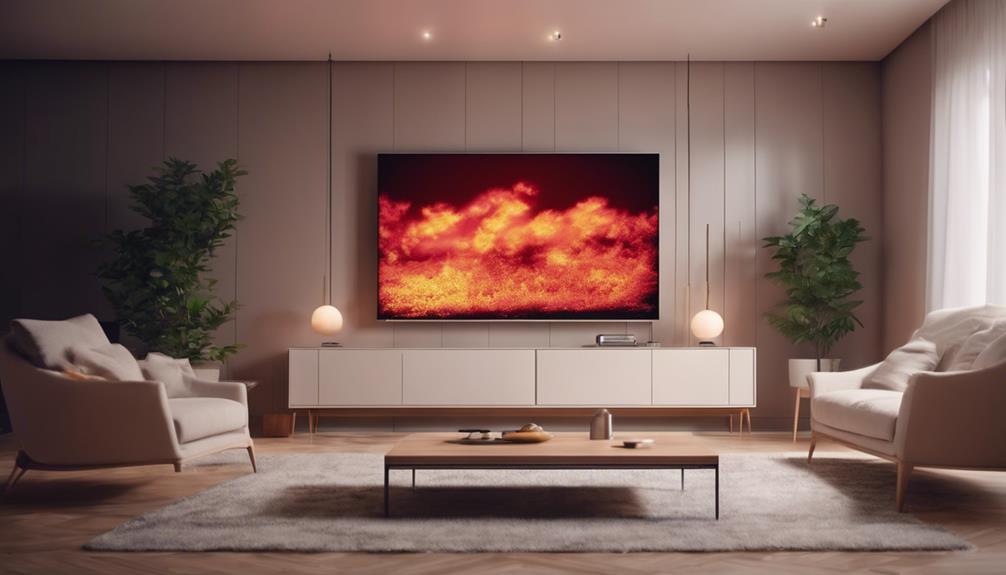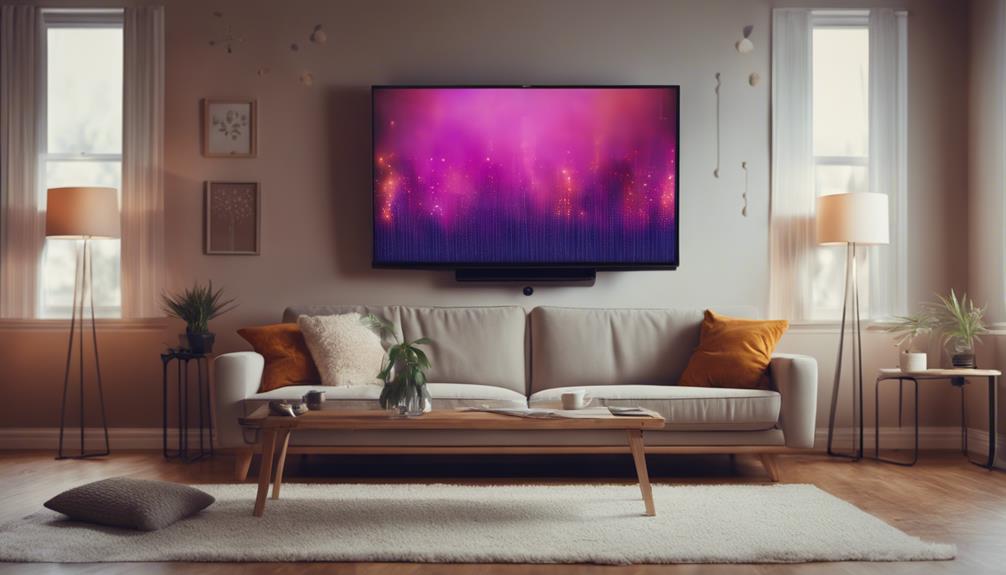
Maximize your energy efficiency and savings by using infrared heaters. Directly heating objects reduces allergens and dust in the air, maintaining natural humidity levels for better respiratory health. These heaters convert nearly all energy into heat, lowering bills and reducing your carbon footprint. By emitting infrared radiation, they efficiently warm objects without wasting energy on heating the air in between. The focused heat transfer optimizes energy usage, making it a cost-effective solution for long-term savings. Choosing the right infrared heater tailored to your space size and heating needs can further enhance performance and efficiency.
Benefits of Infrared Heaters

One of the primary advantages of using infrared heaters is their ability to heat objects directly without needing to warm the surrounding air. This targeted heating method results in significant health benefits as it reduces the circulation of allergens and dust particles in the air, providing a cleaner and healthier environment for you and your loved ones.
Additionally, by not relying on air circulation to distribute heat, infrared heaters help maintain the natural humidity levels in the room, preventing dry air that can lead to respiratory issues.
Moreover, the environmental impact of infrared heaters is remarkably positive. These heaters operate efficiently, converting nearly all the energy they consume into heat, unlike traditional heaters that can waste energy through heat loss in ducts or exhaust gases.
This high efficiency not only saves you money on energy bills but also reduces your overall carbon footprint, making infrared heaters an eco-friendly heating option for your home.
How Infrared Heaters Work
Infrared heaters work by emitting infrared radiation that directly heats objects and individuals in their path, similar to the way the sun warms the earth. This process is made possible through infrared technology, which allows for efficient heat transfer without needing to warm the air in between.
Unlike traditional heaters that rely on convection to circulate warm air, infrared heaters emit invisible light waves that generate heat upon contact with a surface. This means that the heat produced is absorbed by people, furniture, and walls directly, leading to faster and more targeted heating.
The key advantage of this method is that it reduces energy wastage by avoiding heating the entire room, focusing instead on heating the specific objects and individuals within the heater's range.
Infrared heaters are effective in outdoor spaces as well, as they warm objects rather than wasting energy heating the air. This targeted approach to heat transfer makes infrared heaters a cost-effective and energy-efficient heating solution for both indoor and outdoor settings.
Energy Efficiency Explained

To understand energy efficiency in the context of infrared heaters, it's essential to grasp how heat is transferred in a targeted manner, optimizing energy usage.
Energy conservation is a key aspect when considering heating alternatives, and infrared heaters excel in this area.
Traditional heating systems often lose energy through ducts or in heating the air, whereas infrared heaters directly warm people and objects in the room, minimizing energy wastage.
This focused approach reduces the amount of heat lost and guarantees that the energy consumed is used efficiently to create a comfortable environment.
By heating specific areas or zones, infrared heaters provide a cost-effective solution that can lead to significant energy savings over time.
Compared to conventional heating methods, where warm air tends to rise and dissipate, infrared heaters offer a more direct and efficient way to heat spaces, making them a smart choice for those looking to maximize energy efficiency.
Cost Savings With Infrared Heaters
Maximize your energy savings with the efficient cost-effective performance of infrared heaters. When considering cost savings with infrared heaters, it's crucial to look at both initial investment and operational costs. While the upfront cost of installing infrared heaters may be slightly higher than traditional heating systems, the long-term benefits far outweigh this initial expense.
Infrared heaters are known for their energy efficiency, which directly translates to lower operational costs. By efficiently heating objects and people directly, rather than wasting energy heating the air, infrared heaters can reduce energy consumption considerably. This efficiency means you'll see savings on your monthly energy bills, making them a smart choice for cost-conscious individuals and businesses alike.
Moreover, infrared heaters are a long-term investment that pays off over time. Their durability and low maintenance requirements contribute to their cost-effectiveness, ensuring that you continue to save money on heating expenses for years to come. By choosing infrared heaters, you're not only saving on operational costs but also making a wise investment in your energy efficiency and long-term financial savings.
Installation and Maintenance Tips

For efficient performance and longevity of your infrared heaters, consider these installation and maintenance tips.
When installing your infrared heaters, follow specific guidelines to guarantee optimal functionality. Start by positioning the heater at the recommended height and angle for the best heat distribution. Make sure there are no obstructions blocking the infrared waves to maximize efficiency. Additionally, confirm proper electrical wiring and consult a professional if needed to assure safety.
Regular maintenance is essential to keep your infrared heaters in top condition. Create a maintenance checklist that includes cleaning the heater's surface regularly to prevent dust buildup, which can reduce its effectiveness. Check for any loose connections or signs of wear and tear that may affect performance. Inspect the reflectors for damage and replace if necessary to maintain efficient heat distribution.
Choosing the Right Infrared Heater
When selecting the right infrared heater, consider your space's size and heating needs to guarantee peak performance and energy efficiency.
There are various heater types to choose from, including wall-mounted, ceiling-mounted, portable, and outdoor infrared heaters. Wall-mounted heaters are suitable for smaller spaces, providing localized warmth. Ceiling-mounted heaters work well for larger areas, distributing heat evenly across the room. Portable infrared heaters offer flexibility and can be moved to different locations as needed. Outdoor infrared heaters are designed to withstand outdoor conditions, making them ideal for patios or outdoor seating areas.
Size considerations are essential when choosing an infrared heater. Ascertain the heater's heating capacity matches the size of the space you intend to heat. Selecting a heater that's too small may result in inadequate heating, while choosing one that's too large can lead to wasted energy.
Case Studies: Real Savings Examples

Consider real-life examples of how individuals have saved on energy costs by utilizing infrared heaters in their homes and businesses.
User testimonials highlight significant savings achieved through the efficient use of infrared heaters. For instance, homeowner Jane reported a 30% decrease in her monthly heating expenses after switching to an infrared heater in her living room. She noted that the targeted warmth provided by the infrared heater allowed her to lower the overall thermostat setting, resulting in substantial cost savings without compromising comfort.
In a commercial setting, a small business owner, Mark, shared his experience of reducing heating costs by 40% in his workshop by incorporating infrared heaters. Mark explained that the ability of the infrared heaters to heat objects directly, rather than wasting energy on heating the air, led to a noticeable drop in his energy bills while maintaining a comfortable working environment for his employees.
These real-life examples demonstrate the tangible savings achievable through the utilization of infrared heaters in various settings.
Conclusion
To summarize, maximizing energy efficiency with infrared heaters can lead to significant cost savings.
By understanding how these heaters work and following proper installation and maintenance tips, you can guarantee your heating system is running at peak efficiency.
With the potential for real savings demonstrated in case studies, investing in an infrared heater is a smart choice for both your wallet and the environment.
Make the switch today and start enjoying the benefits of energy-efficient heating.

